In my experience within the training industry, I’ve seen the significant impact of compliance training. Adhering to regulations and policies regarding safety and ethics is vital.
Many organizations struggle with engagement and keeping the content current, which can lead to severe gaps in legal compliance.
Considering these aspects, I have created an informative post to educate you on the best practices and strategies for enhancing your online compliance training programs.
But before that, let’s start with the basics.
What Is Compliance Training?
Compliance training is the process of educating employees about the laws, regulations, and company policies that apply to their jobs and the organization as a whole.
It’s essentially a way to make sure everyone on the team is on the same page about what’s expected of them and how to operate within the legal and ethical boundaries of the industry and company.
Examples & Types of Compliance Training & the Sectors That Need It
1. Health and Safety Training
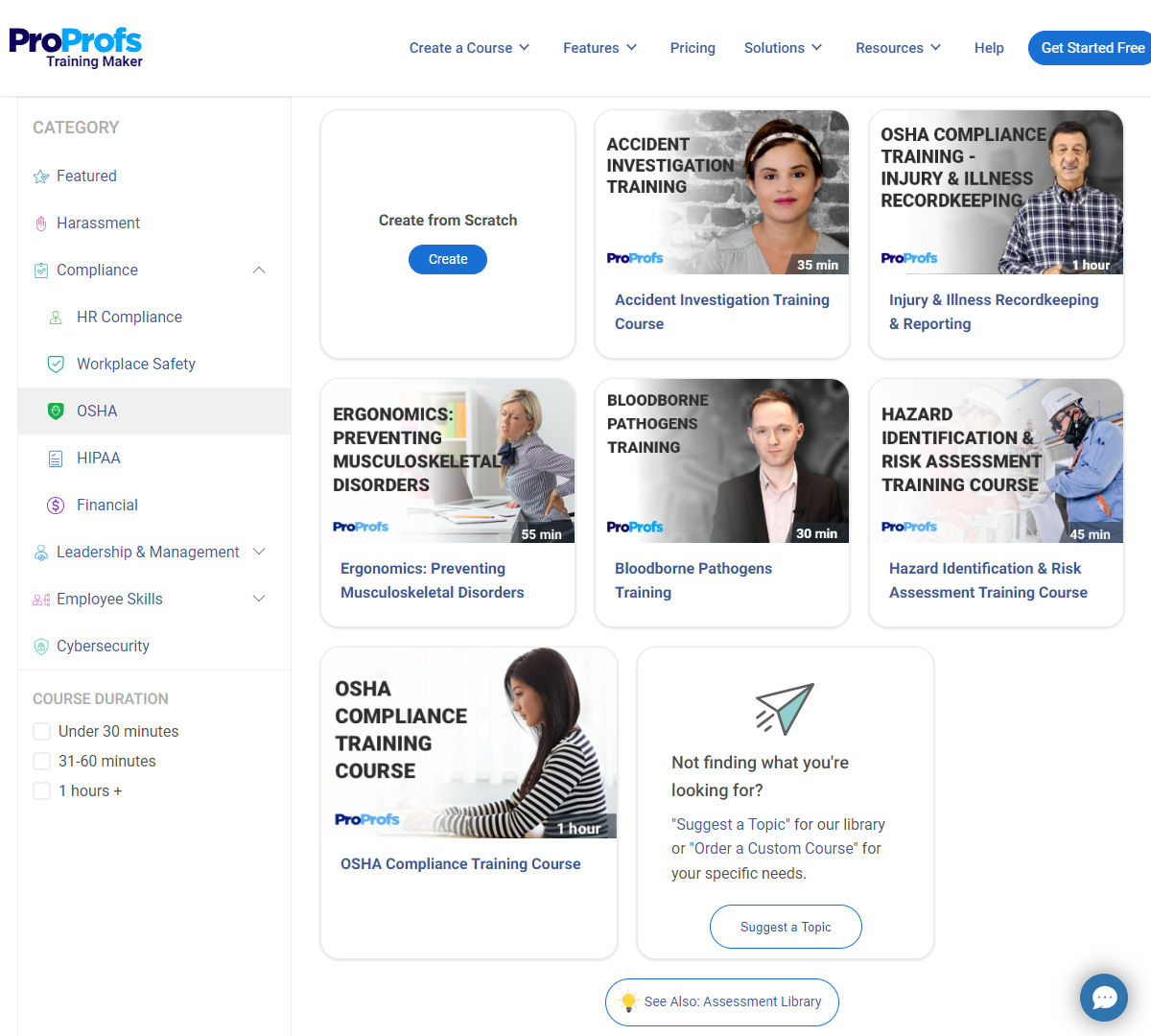
Health and safety training aims to create a safe working environment. It trains employees about the risks in their work area, the correct procedures for maintaining safety, and how to respond to emergencies. This type of training helps ensure that workplaces meet the standards set by OSHA and HIPAA.
Such training also covers properly using personal protective equipment and minimizing potential dangers. This ensures everyone knows how to operate safely and can help reduce work-related injuries.
It is suitable for: Construction, Manufacturing, Healthcare, Hospitality, Transportation, and Logistics (basically any industry with potential physical risks).
Why: These industries have a high potential for accidents due to machinery, hazardous materials, or physical labor. Training minimizes risks and ensures worker safety.
2. Data and Cybersecurity Training
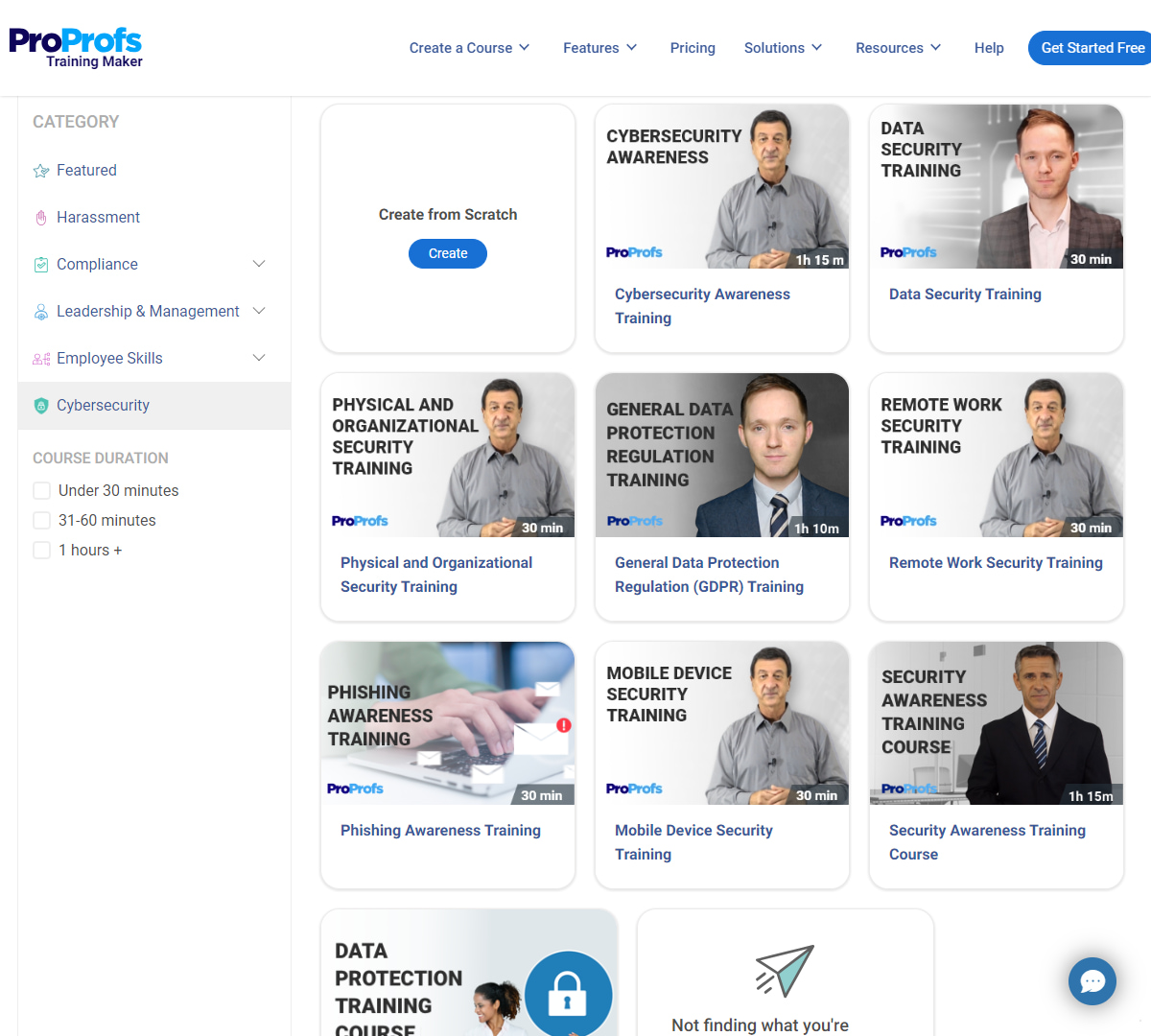
In this training, employees learn the importance of safeguarding digital information. It teaches them how to handle sensitive data correctly to prevent leaks and breaches. This includes understanding the risks of cyber threats and the measures to protect against them.
The training is crucial for those in roles dealing with personal customer data or sensitive financial information, ensuring they know the protocols to keep this data secure.
Suitable for: Finance, Healthcare, Technology, Government, Retail (any industry handling sensitive data)
Why: These industries handle sensitive customer data (financial information, medical records) or intellectual property. Training protects this data from breaches and cyberattacks.
3. Ethics Training
Ethics training is an essential part of online compliance training as it promotes integrity within the workplace. It teaches employees about acceptable conduct, avoiding ethical dilemmas, and properly using company resources.
This training also emphasizes the importance of transparency and honesty in all company dealings. It guides employees on how to report unethical behavior, fostering a trustworthy and ethical work environment.
Suitable for: All Industries (especially Finance, Government, and Non-Profits).
Why: Strong ethical conduct is crucial in all businesses, but especially in finance, government, and non-profits, where ethical lapses can have significant repercussions.
4. Diversity, Equity and Inclusion (DEI) Training
DEI training educates employees on the value of diversity in the workplace. Diversity training addresses the various facets of human difference, fostering an environment of respect and empathy.
Inclusion training goes further by empowering employees to support a collaborative and supportive working environment. This ensures that all employees feel included and valued regardless of their backgrounds.
Suitable for: All Industries (especially Customer-Facing Roles)
Why: Diversity and inclusion are essential for fostering creativity, innovation, and a positive work environment. Training benefits all industries, especially those with customer-facing roles where representing a diverse clientele is essential.
5. Sexual Harassment Prevention Training
Through anti-harassment training, employees learn what constitutes harassment and how to prevent it. This training defines harassment, outlines its various forms, and provides strategies for addressing harassment in the workplace.
It equips
Get This SMART Goals Training Course
employees with the tools to report inappropriate behavior effectively. The goal is to cultivate a workplace culture that respects individual dignity and promotes professionalism.
Suitable for: All Industries
Why: Harassment-free workplaces are essential for employee well-being and productivity (regardless of the industry). Training prevents harassment, promotes respectful conduct, and creates a safe work environment.
6. Other Types of Compliance Training
Compliance training varies by industry and organization but generally covers the legal and ethical standards applicable to a specific work environment. This can include anti-bribery and corruption training, which teaches employees about lawful conduct in business dealings. Export compliance training deals with the regulations surrounding trade and exports.
Environmental compliance training helps organizations comply with laws designed to protect the environment. These programs ensure that employees understand and adhere to relevant laws and regulations, helping to prevent legal issues and promoting ethical business practices.
Why Is Compliance Training Important?: The Top Benefits
Compliance training is essential for multiple reasons. From my experience, I’ve seen firsthand how vital compliance training is for organizations. It truly brings a slew of advantages that bolster a business’s legal and ethical framework. Let me break down the benefits I’ve observed:
- Minimized Legal Risks: When we educate our employees about the laws, regulations, and internal policies that affect our operations, we drastically reduce the chances of legal troubles. This means fewer fines, lawsuits, or the nightmare of criminal charges. It’s all about keeping things above board and transparent.
Expert tip—For employee training, we have used an LMS, which helped us not only create courses but also track and manage all learning activities. We chose an LMS because it enabled us to repurpose our content as well. So, we didn’t have to change the whole thing whenever there was a new regulation. We just edited whatever was required. So, as a bonus tip, I would suggest always going for an LMS when training your employees. - A Safer and More Inclusive Workplace: Topics like anti-harassment are staples in compliance training. It’s about building a workspace where everyone feels safe and valued. Plus, training our team on how to spot and report issues means communication stays open, and everyone holds themselves accountable.
- Legal Compliance: It’s simple—when our team knows the rules, they’re less likely to break them by mistake or intentionally. This keeps our organization out of hot water and ensures legal smooth sailing.
- Ethical Behavior: This training does more than tell our team to follow the law. It embeds a sense of ethics and integrity in everything we do. We want our people to act honestly and with moral clarity in every business interaction.
- Boosted Reputation: A solid compliance program shows everyone—clients, investors, and the public—that we’re serious about doing things right. This can only enhance our credibility and build trust, which is gold in today’s market.
- Enhanced Risk Management: We arm our team with the right knowledge so they can spot potential issues early on. This proactive approach is key to avoiding big losses, whether financial, reputational, or operational.
What Are the Key Elements of an Effective Compliance Program?
An effective compliance program is essential for organizations that want to operate ethically and within the law. It helps prevent misconduct, identify and address problems early on, and minimize the risk of legal and financial penalties.
Here are the key elements of an effective compliance program:
- Written policies and procedures: Clear and concise policies outline the organization’s expectations for ethical conduct and compliance with relevant laws and regulations. These policies should be easy to understand and accessible to all employees.
- Designated compliance officer and compliance committee: A compliance officer oversees the compliance program and ensures its effectiveness. The compliance committee is a group of senior executives who provide guidance and oversight to the compliance officer.
- Effective training and education: Regular employee training programs are important because they educate employees about the organization’s compliance policies and procedures and relevant laws and regulations. Training should be tailored to the specific needs of different employee groups.
- Effective lines of communication: Open and anonymous channels for employees to report suspected violations of compliance policies or the law. This could include a hotline, email address, or website.
- Internal monitoring and auditing: Regular monitoring and auditing activities should be integral to compliance training. This helps identify potential compliance risks and weaknesses. Internal monitoring can include risk assessments and internal audits.
- Enforcement of standards through well-publicized disciplinary guidelines: A clear and consistent process is crucial for enforcing compliance standards. This should include disciplinary guidelines that outline the potential consequences of non-compliance.
- Prompt response to detected problems and undertaking corrective action: There should be a process for investigating suspected violations and taking corrective action to address any identified problems. This could include disciplinary action, changes to policies and procedures, or additional training.
- Compliance metrics: Regularly track and measure the effectiveness of the compliance program. This could include data on the number of reported violations, the types of violations, and the outcomes of investigations.
By implementing these key elements, organizations can create a strong compliance program that helps to prevent misconduct, promote ethical behavior, and minimize legal and financial risks.
Get Free Employee Training Software — All Features, Forever.
We've helped 567 companies train 200,000+ employees. Create courses in under a minute with our AI LMS or use 200+ ready-made courses on compliance, harassment, DEI, onboarding, and more!
What Are the Common Challenges in Implementing Online Compliance Training?
Sometimes, despite our best efforts to craft effective online compliance training, things can go awry. Even with multiple initiatives, the desired outcomes may not always materialize. I have seen many companies across the industry struggle with challenges that hinder the effectiveness of their compliance training programs.
- Content Management and Updates: Keeping compliance training up-to-date with regulation changes can be a technical nightmare. Manually updating the course content across an LMS is cumbersome and error-prone.
Does your LMS require you to update content and manage all learning activities manually? I have a solution: Try this training maker. It will save you precious time and effort. Don’t take my word for it; just try it! - Accessibility for Diverse Learners: Compliance training must be accessible to a wide range of learners with varying technical skills and abilities. This might involve features like closed captions for videos, dyslexia-friendly fonts, and mobile compatibility for on-the-go learning. Accommodating all learners can be a big challenge.
- Integration With Existing Systems: Ideally, compliance training should integrate seamlessly with existing HR or payroll systems. This allows for automated enrollment, progress tracking, and reporting, reducing administrative burdens. However, integrating various platforms can be complex due to differing APIs and data formats.
- Scalability and Security: As the number of trainees grows, the LMS must be scalable to handle increased traffic and data storage. Security is paramount, as compliance training might deal with sensitive information. The LMS must ensure data privacy and prevent unauthorized access.
- Data Analytics and Reporting: Effective training and compliance requires tracking completion rates, knowledge retention, and identifying areas where employees struggle. The LMS should provide robust reporting features to analyze this data and measure the effectiveness of the training programs.
If these challenges sound familiar, you’re not alone. I have seen the best of the best companies penalized for noncompliance (even when they had compliance training in place). So, just having provisions for training is not enough. It has to be implemented in the right way. Keeping this in mind, I have created a solid plan to help you develop a robust compliance training program.
How to Develop a Compliance Training Program: 7 Key Steps & Best Practices
When creating a compliance training program, I suggest you understand which industry you cater to and who your audience is. Every industry has unique compliance needs. For example, the manufacturing industry in the USA must adhere to the Environmental Protection Agency (EPA) regulations. Meanwhile, the healthcare sector is governed by the Health Insurance Portability and Accountability Act (HIPAA) for patient privacy and the Federal Drug Administration (FDA) regulations for drug and treatment approvals. Knowing these specifics helps tailor your program effectively and ensures it addresses the right compliance issues for your audience.
Once you identify your target audience, there are 7 essential steps you need to follow. Here’s what it looks like:
1. Analyze Compliance Training Needs
Why:
Identify the areas where employees need training to comply with regulations, company policies, or ethical standards.
How:
Conduct a training needs assessment through surveys, focus groups, or analyzing past incidents. You can also conduct a skills gap analysis to understand the specific skills lacking in their workforce.
When:
Do this before developing compliance training for employees to ensure the training addresses actual needs.
2. Gather Resources for Training Materials
Why:
Compile relevant regulations, policies, best practices, and any external resources needed to create the training content.
How:
Work with legal, HR, and subject matter experts to gather accurate and up-to-date information.
When:
Throughout the development process, as you determine the specific content required.
3. Map the Points of Impact
Why:
Identify the roles and departments most affected by the compliance requirements.
How:
Analyze job descriptions, workflows, and risk assessments to pinpoint areas of potential non-compliance.
When:
Do this after the needs assessment to tailor the training to different employee groups.
4. Create a Winning Compliance Training Program
Why:
Design engaging and informative training that effectively communicates compliance expectations.
How:
- Define Learning Objectives: Set clear goals for what employees should know and be able to do by the end of the training. SMART goals step into the picture here. They ensure clear and measurable objectives, fostering focused efforts and better achievement tracking.
- Choose the Right Delivery Method: Based on learner preferences and content complexity, consider instructor-led training, eLearning modules, videos, or blended approaches.
- Incorporate Adult Learning Principles: Use storytelling, case studies, scenarios, and interactive elements to keep learners engaged and improve knowledge retention.
When:
This is the core development stage, and the timeline will depend on the complexity of the program.
5. Develop Assessment and Evaluation Tools
Why:
Measure the effectiveness of the training in meeting learning objectives and ensuring knowledge retention.
How:
Create quizzes, knowledge checks, or practical exercises to assess trainee understanding.
Include opportunities for feedback to identify areas for improvement in the training program itself.
When:
Develop assessments alongside the training content and gather feedback after program completion.
6. Implement and Deliver the Training Program
Why:
Roll out the training program to the target audience.
How:
Schedule training sessions, ensure accessibility for all employees, and provide clear communication about program expectations.
Consider offering the training in multiple formats to cater to different learning styles.
When:
Deliver the training after development and testing are complete, considering factors like employee availability and workload. As I already said, you can use an LMS to deliver training.
Here’s a customer testimonial: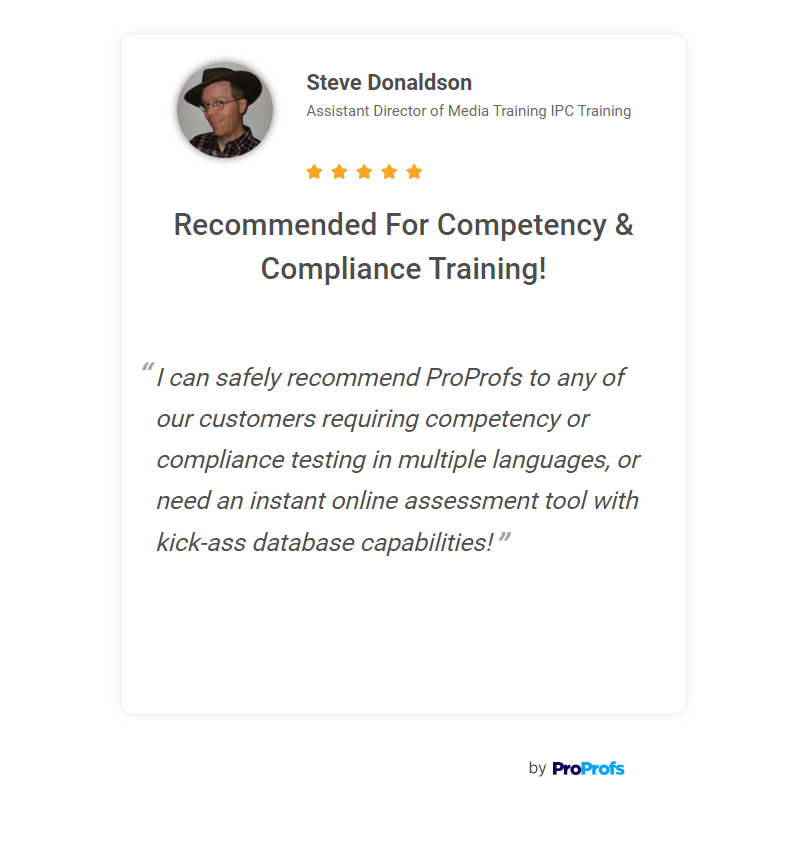
7. Monitor and Maintain the Training Program
Why:
Ensure the training program remains relevant and effective over time.
How:
Track completion rates, analyze assessment results, and gather feedback from employees and trainers.
Update the training content regularly to reflect any changes in regulations or company policies.
When:
Monitor the program continuously, scheduling updates as needed.
By following these steps and addressing each stage’s why, how, and when, you can develop a comprehensive and effective compliance training program that keeps your organization on the right side of regulations and ethical conduct.
Best Compliance Training Programs: Start Your Training Today!
Here are a few quick resources to kickstart your compliance training for employees:
1. OSHA Compliance Training: This course is designed to help organizations ensure they align with OSHA standards, covering various workplace safety regulations. It’s essential for maintaining a safe work environment and avoiding penalties.
2. HIPAA Compliance Training: Aimed at healthcare professionals, this course covers the Health Insurance Portability and Accountability Act regulations, ensuring patient information is handled securely and privately.
3. Sexual Harassment Prevention: This course provides crucial training on preventing sexual harassment, which helps create a respectful and safe workplace. The course meets U.S. Federal and State requirements so that employees understand their legal rights and obligations.
4. Emergency Preparedness & Response Action Plan: This plan prepares employees to respond effectively to emergencies, covering action plans and safety protocols and ensuring an organized response to unexpected situations.
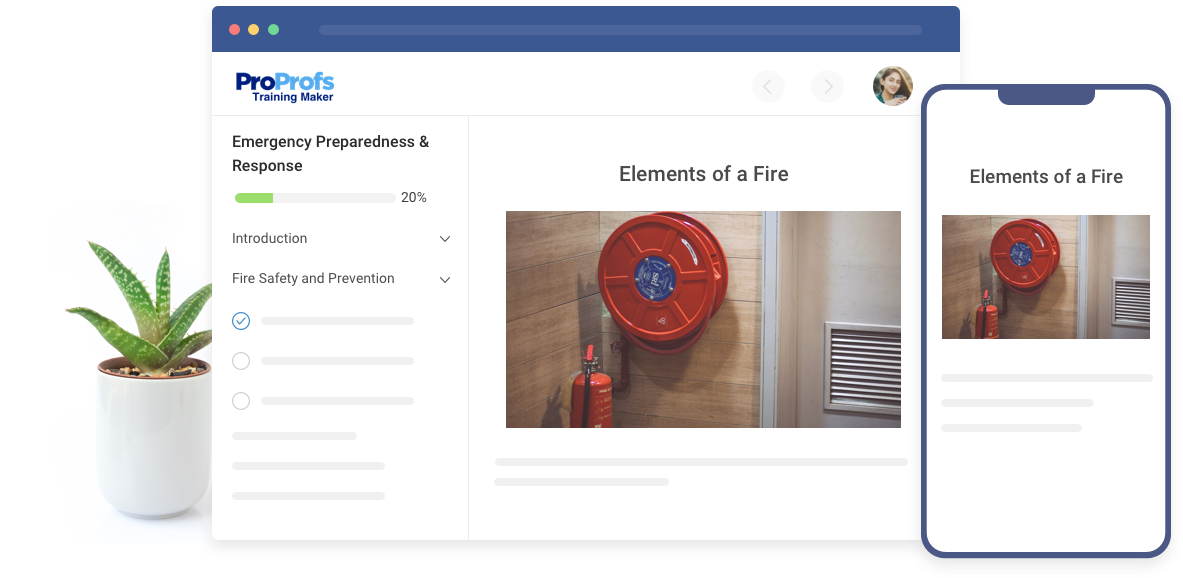
5. Fair Labor Standards Act Training: This course educates on the FLSA, which sets standards for minimum wage, overtime pay, and youth employment, crucial for HR professionals and managers.
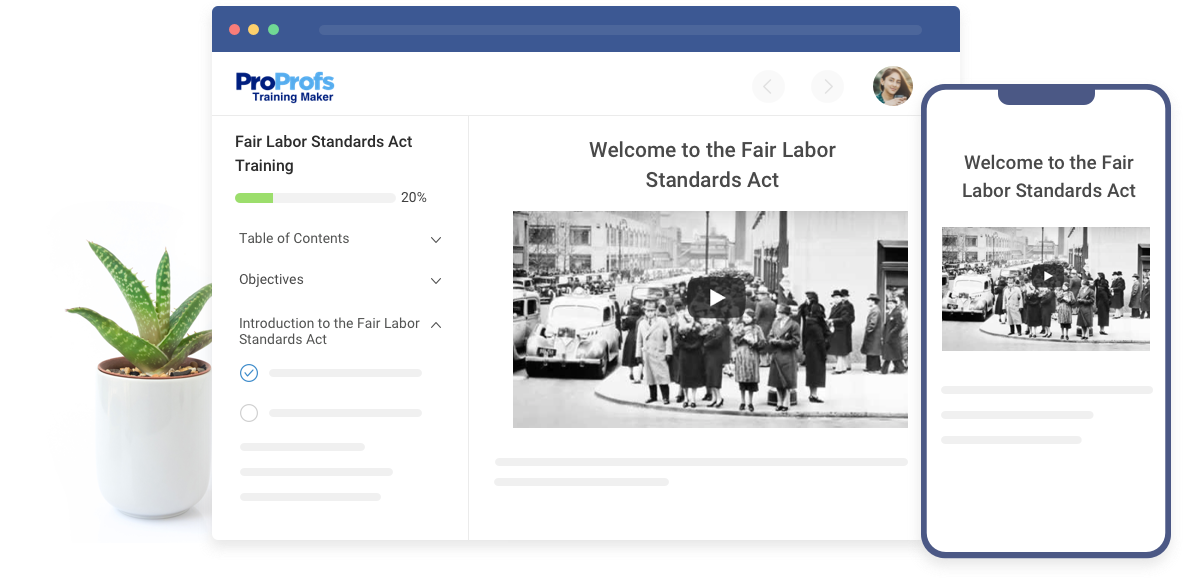
6. HAZMAT Training for Healthcare Workers: Healthcare workers learn to handle hazardous materials safely, an essential skill for maintaining safety standards and compliance in healthcare facilities.
Empower Your Workforce With Effective Compliance Training
Compliance training might seem like a necessary hurdle, but it can also be a powerful tool for empowering your workforce. Equipping your employees with the knowledge they need to steer legal and ethical complexities can foster a culture of integrity, minimize risks, and build a stronger organization.
Remember, the key lies in understanding your audience, customizing content, and using engaging formats. Following the steps outlined and leveraging the best practices discussed, you can transform compliance training from a chore to a strategic advantage.
Hopefully, you found this article insightful and feel empowered to take the next step in creating a robust compliance training program for your organization.
Get Free Employee Training Software — All Features, Forever.
We've helped 567 companies train 200,000+ employees. Create courses in under a minute with our AI LMS or use 200+ ready-made courses on compliance, harassment, DEI, onboarding, and more!
Frequently Asked Questions
What role does technology play in modern compliance training?
Technology plays a significant role in modern compliance training. For example, e-learning platforms offer accessible and flexible training anytime, anywhere. Similarly, simulations and mobile apps can create engaging scenarios to reinforce learning. These tools also allow for easy tracking of employee progress and completion of training modules.
Is compliance training the same as ethics training?
Compliance and ethics training are not the same, although they can be complementary. Compliance training focuses on following specific rules and regulations, including laws, company policies, and industry standards. Ethics training focuses on developing a strong moral compass and making decisions based on values, even when the rules are unclear. Check out this guide on ethics training!
What is the difference between compliance training and corporate training?
Compliance training is a specific type of corporate training. All compliance training falls under the umbrella of corporate training, but not all corporate training is compliance training. Compliance training focuses on adherence to regulations and legal requirements in a particular area. Conversely, corporate training can cover a wider range of topics, including job skills, company procedures, and professional development.
What are the latest trends in compliance training?
The latest trends in 2024 compliance training embrace technology for a more personalized learning experience. Data analytics pinpoint individual needs, while microlearning delivers bite-sized, relevant content. Gamification adds a fun twist, and virtual/augmented reality creates immersive simulations for practical applications. This shift towards dynamic, user-centric training methods reflects how organizations adapt to the needs of today’s workforce.
How often should compliance training be conducted?
The frequency of compliance training depends on the specific regulation and the level of risk involved. Some regulations require annual training, while others might mandate it more frequently. It’s important to consult the relevant regulations and industry best practices to determine the appropriate frequency for your organization.
How can you ensure compliance training is up-to-date with current laws and regulations?
Ensuring your compliance training stays current requires consistent monitoring of legal and regulatory changes. Valuable resources include government websites, industry association updates, and legal news services. Stay informed; you can promptly update your training content to reflect changes and ensure your employees have the latest knowledge.
What are the consequences of non-compliance?
The consequences of non-compliance with regulations can be severe. Organizations may face hefty fines, lawsuits, and reputational damage. In serious cases, non-compliance can lead to the loss of business licenses or even criminal charges for individuals or the organization itself. Therefore, a strong compliance training program is essential to mitigate these risks.
 Tips
Tips
We’d love to hear your tips & suggestions on this article!
Get Free Employee Training Software — All Features, Forever.
We've helped 567 companies train 200,000+ employees. Create courses in under a minute with our AI LMS or use 200+ ready-made courses on compliance, harassment, DEI, onboarding, and more!

 We'd love your feedback!
We'd love your feedback! Thanks for your feedback!
Thanks for your feedback!



![10 Best Compliance Training Software for 2025 [Updated List]](https://www.proprofstraining.com/blog/wp-content/uploads/2023/03/X_Best_Compliance_Training_Software_in_2023.png)



